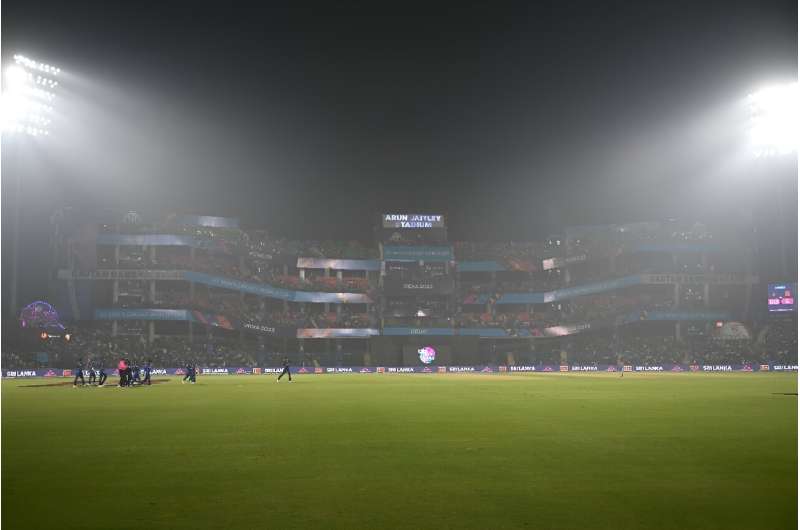This article has been reviewed according to Science X's editorial process and policies. Editors have highlighted the following attributes while ensuring the content's credibility:
fact-checked
reputable news agency
proofread
Fans forgo facemasks as India's toxic smog clouds World Cup

The smog-choked Indian capital was ranked as the planet's most polluted major city on Monday, but the love of the game trumped health worries for fans at the cricket World Cup.
Both Bangladesh and Sri Lanka had cancelled training sessions ahead of their match in New Delhi worried at health impacts, but players took to the pitch without facemasks—and barely a handful of the thousands of fans in the stadium took precautions either.
"If I was worried about the pollution, I could have stayed home to watch on TV," said Arun Sikdar, a shopkeeper, who had brought his seven-year-old son to see the game.
With no signs of improvement in the megacity's choking levels of pollution, city authorities on Sunday extended emergency school closures for a week.
At a stall outside the stadium, Sikdar lined up with other families to have Indian flags painted on their faces before heading in to watch the game.
"Wearing a mask would hide the flag," he pointed out.
"We live with the pollution every winter, and today is not a bad day compared to some."
By mid-afternoon, the sun had burned through clouds to leave only a milky haze across the pitch.
Levels of PM2.5 microparticles that enter the bloodstream through the lungs remained dangerously high—more than 12 times World Health Organization limits—but that did little to dampen spirits.
Short-term impacts can include a burning throat, streaming eyes and a hacking cough. Diehard fans shrugged off the pain.
"You learn to live with pollution," said Sajid Shah, watching the match on his day off from work at a telecommunication company.
"After all, you can't spend all the weeks of pollution stuck only inside. You have to live a little."
Long-term consequences can include strokes, heart disease, lung cancer and respiratory diseases, according to the World Health Organization, which calls air pollution "one of the greatest environmental risks to health".
Like '30 cigarettes a day'
New Delhi is blanketed in acrid smog every autumn, primarily blamed on stubble burning by farmers in the neighboring regions.
"I get headaches on bad days, and a sore throat, but that's worth it to watch the World Cup in person," Shah added. "Anyway, what can we do?"
The average city resident could die nearly 12 years earlier due to air pollution, according to an August report by the University of Chicago's Energy Policy Institute.
Sandeep Rajesh, a 70-year-old retired civil servant, was one of just a handful of spectators donning a face mask, saying he had got used to wearing one during the coronavirus pandemic.
"People think the health problems are just a sore throat, they don't think about the long-term impacts," he said, before accepting that "sitting for eight hours to watch a match is probably not the wisest thing to do."
He pointed to an article in the Times of India newspaper he carried, in which medics recommended facemasks and curtailing outdoor activities when pollution was high.
"Even healthy people should work from home if possible", it quoted pulmonologist Dr. Vivek Singh as saying. "The current air quality is like smoking 20-30 cigarettes a day."
© 2023 AFP



















